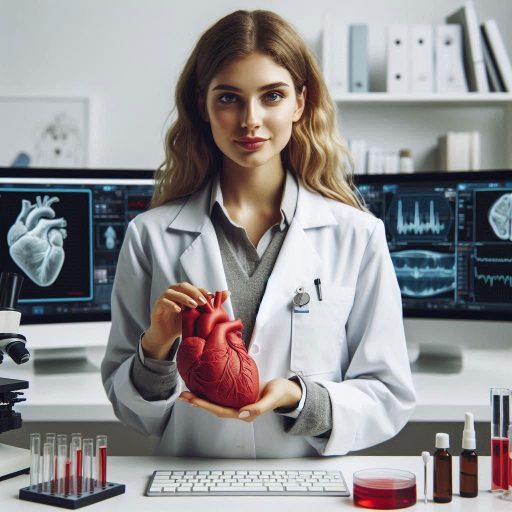Introduction
Biomedical engineers play a crucial role in healthcare and disease prevention.
They combine engineering principles with medical sciences to develop innovative solutions.
Their work leads to advancements in medical devices, diagnostics, and therapeutic strategies.
By understanding the human body and disease mechanisms, they create tools that enhance patient care.
These professionals design prosthetics and implants that improve patients’ quality of life.
They also develop imaging technologies that allow for early disease detection.
For instance, MRI and CT scans help identify tumors before they progress.
Their expertise extends to creating software that analyzes medical data for better treatment plans.
Biomedical engineers work closely with doctors, researchers, and healthcare professionals.
This collaboration ensures that their innovations meet clinical needs effectively.
Their contributions also include developing biocompatible materials that minimize rejection in patients receiving implants.
Moreover, they focus on creating systems for drug delivery, making treatments more efficient.
The importance of biomedical engineering in healthcare cannot be overstated.
It significantly impacts disease prevention and management.
By developing advanced diagnostic tools, biomedical engineers enable early intervention.
This proactive approach can save lives and reduce healthcare costs.
As technology advances, their role will continue to evolve, leading to even more breakthroughs in fighting diseases.
Biomedical engineering is essential for a healthier future.
Research and Development
Biomedical engineers play a crucial role in the research and development of technologies to combat diseases.
They combine engineering principles with medical knowledge to create innovative solutions that improve patient outcomes.
Their research often leads to breakthroughs in treatment methods and technologies that save lives.
Biomedical engineers conduct research to develop new technologies and treatment methods for diseases
One significant area of focus is the development of medical devices.
Biomedical engineers design advanced imaging systems, such as MRI and CT scanners.
These devices allow doctors to diagnose diseases accurately and quickly.
Enhanced imaging techniques improve disease detection rates, leading to timely interventions.
Another vital contribution is the development of prosthetics and implants.
Engineers create artificial limbs that restore mobility for amputees.
Modern prosthetics use advanced materials and technology to mimic natural movement.
They also incorporate sensors that provide feedback to the user.
This innovation greatly enhances the quality of life for patients.
Breakthroughs in Treatment Methods
Biomedical engineers also focus on drug delivery systems.
They design methods to deliver medications more effectively and safely.
For instance, targeted drug delivery systems direct treatment to specific areas in the body.
This approach minimizes side effects and maximizes treatment efficacy.
Such advancements lead to improved therapies for conditions like cancer.
Tissue engineering is another groundbreaking area within biomedical engineering.
Researchers create artificial tissues and organs to replace damaged ones.
This field holds promise for patients with organ failure.
Bioengineered tissues can help restore function and reduce reliance on organ donors.
Advances in stem cell technology further enhance these efforts.
Moreover, biomedical engineers contribute to the field of genomics.
They work on techniques to analyze genetic information and identify disease markers.
Understanding genetic predispositions enables personalized medicine approaches.
Tailoring treatments based on an individual‘s genetic makeup improves success rates.
Recent Advancements
In recent years, biomedical engineers have made strides in the fight against infectious diseases.
They develop diagnostic tools that allow for rapid detection of pathogens.
Quick identification of diseases like COVID-19 has proven essential in managing outbreaks.
Such tools enable healthcare providers to respond swiftly and effectively.
Biomedical engineers are also at the forefront of vaccine development.
They leverage technology to create more effective vaccines in shorter time frames.
Recent advancements have led to mRNA vaccine technology, revolutionizing the vaccine landscape.
This technology played a critical role in the global response to the COVID-19 pandemic.
Continuous Research and Collaboration
Finally, biomedical engineers engage in continuous research to understand disease mechanisms.
They collaborate with researchers and clinicians to translate findings into practical applications.
This collaboration drives innovation in the medical field and leads to new treatment options.
In review, biomedical engineers significantly impact disease research and treatment development.
Their work leads to innovations that improve patient care and enhance health outcomes.
Through continuous research and collaboration, they remain vital in the fight against diseases, shaping the future of healthcare.
Read: U.S. Cities with the Most Opportunities for Environmental Scientists
Medical Imaging
Biomedical engineers play a crucial role in advancing medical imaging technologies.
These professionals develop tools that improve early detection and diagnosis of diseases.
Early detection significantly increases the chances of successful treatment.
Advanced imaging techniques allow healthcare providers to visualize internal structures of the body more clearly.
Improving Medical Imaging Technologies
One prominent imaging technology is magnetic resonance imaging (MRI).
MRI uses strong magnetic fields and radio waves to create detailed images.
These images help diagnose conditions such as tumors, brain disorders, and joint issues.
Engineers continually enhance MRI technology, making it faster and more efficient.
Improved MRI scans provide clearer images, enabling doctors to make better-informed decisions.
Another essential imaging technique is computed tomography (CT).
CT scans combine X-ray images taken from different angles to create cross-sectional views.
This technique is vital for diagnosing internal injuries and diseases.
Biomedical engineers work to reduce the radiation exposure during CT scans.
They aim to enhance image quality while keeping patients safe.
Ultrasound imaging is also a critical tool in disease management.
This technique uses high-frequency sound waves to create images of organs and tissues.
Biomedical engineers innovate ultrasound technology to improve its resolution and accuracy.
Enhanced ultrasound capabilities allow for better monitoring of fetal development and cardiovascular conditions.
This non-invasive technique plays a vital role in preventative medicine.
Impact of Advanced Imaging Techniques
Positron emission tomography (PET) is another advanced imaging technique.
PET scans provide information about metabolic processes in the body.
This technology helps in diagnosing cancers and monitoring treatment responses.
Biomedical engineers enhance PET imaging by improving sensitivity and resolution.
As a result, healthcare providers can detect diseases at earlier stages.
The integration of artificial intelligence (AI) into medical imaging is a game changer.
AI algorithms assist in analyzing imaging data more accurately and efficiently.
Biomedical engineers develop AI tools that can identify patterns and anomalies in images.
These tools support radiologists in making quicker and more accurate diagnoses.
Advanced imaging techniques significantly impact disease management and treatment.
Early detection leads to timely interventions, improving patient outcomes.
For example, detecting cancer at an earlier stage often allows for less aggressive treatments.
This approach can lead to better quality of life and recovery rates.
In essence, biomedical engineers are vital in improving medical imaging technologies.
Their work enables early detection and accurate diagnosis of diseases.
As imaging techniques advance, healthcare providers can manage diseases more effectively.
This ongoing innovation holds great promise for the future of medicine, enhancing patient care and outcomes.
The commitment of biomedical engineers continues to push the boundaries of medical imaging, ensuring better health for all.
Read: Environmental Scientist vs. Ecologist: Roles and Differences in the US
Drug Delivery Systems
Biomedical engineers design and develop innovative drug delivery systems for targeted and efficient treatment of diseases
Biomedical engineers play a crucial role in designing and developing innovative drug delivery systems.
These systems aim to deliver medications directly to specific areas in the body.
By targeting the site of action, they enhance treatment effectiveness.
This targeted approach minimizes the impact on healthy tissues and reduces side effects.
Role of Drug Delivery Systems in Improving Patient Outcomes
Traditional drug delivery methods often distribute medication throughout the entire body.
This can lead to significant side effects and decreased patient compliance.
Innovative drug delivery systems address these challenges by improving the precision of medication administration.
These advancements enable more effective treatment strategies for various diseases.
One promising approach involves using nanoparticles.
These tiny particles can encapsulate drugs, allowing for controlled release over time.
Nanoparticles can penetrate tissues easily and deliver medications to specific cells.
This targeted delivery improves treatment outcomes for conditions such as cancer.
It ensures that higher concentrations of the drug reach the affected area.
Another innovative method is the use of implantable drug delivery devices.
These devices can release medication continuously over an extended period.
For example, insulin pumps provide a steady supply of insulin for diabetes management.
By maintaining consistent drug levels, these devices improve patient outcomes and simplify treatment regimens.
Reducing Side Effects
Biomedical engineers are also exploring smart drug delivery systems.
These systems respond to specific physiological triggers, such as pH changes or temperature fluctuations.
For instance, hydrogels can release drugs in response to changes in the surrounding environment.
This ensures that medications are delivered only when needed, reducing unnecessary exposure and side effects.
Advanced drug delivery systems enhance patient adherence to treatment plans.
By minimizing the frequency of medication administration, patients are more likely to follow their prescribed regimens.
This can lead to better disease management and improved health outcomes.
The role of drug delivery systems extends beyond cancer and diabetes.
They are crucial in treating infectious diseases, autoimmune disorders, and chronic conditions.
By enabling localized delivery, these systems reduce the risk of systemic side effects.
This is particularly important for medications that may cause significant adverse reactions when administered systemically.
In general, biomedical engineers are at the forefront of developing innovative drug delivery systems.
These systems enhance treatment effectiveness by targeting specific areas in the body.
They improve patient outcomes and reduce side effects, ultimately leading to better healthcare solutions.
As technology advances, the potential for drug delivery systems will continue to grow, offering new hope for patients worldwide.
Read: The Relationship Between U.S. Policy & Environmental Scientist Roles
Prosthetics and Medical Devices
Biomedical engineers play a critical role in enhancing the quality of life for patients with chronic illnesses or disabilities.
They design innovative prosthetics and medical devices that significantly improve patient outcomes.
These advancements empower individuals to regain mobility, independence, and overall well-being.
Biomedical Engineers Design Prosthetics and Medical Devices to Improve Quality of Life for Patients with Chronic Illnesses or Disabilities
Biomedical engineers play a crucial role in improving the lives of patients with chronic illnesses or disabilities.
Their work focuses on creating innovative prosthetics and medical devices that restore function and independence.
By addressing physical limitations, they empower individuals to live more fulfilling lives.
Designing Custom Prosthetics for Enhanced Mobility
One of the key areas biomedical engineers excel in is prosthetics design.
These engineers use advanced technologies to develop custom prosthetic limbs that cater to a patient‘s specific needs.
By considering factors like the patient’s physical condition, activity level, and personal preferences, engineers ensure the prosthetic is a perfect fit.
These personalized devices allow patients to perform daily tasks with greater ease and comfort.
Moreover, biomedical engineers continuously innovate to make prosthetics more lifelike and functional.
The integration of robotics and artificial intelligence (AI) in prosthetics has revolutionized the field.
Patients can now control their prosthetic limbs with their thoughts, enhancing mobility and independence.
This cutting-edge technology brings a new level of functionality, enabling users to regain their lost abilities.
Medical Devices to Manage Chronic Illnesses
In addition to prosthetics, biomedical engineers design medical devices that help patients manage chronic illnesses.
Devices such as insulin pumps, pacemakers, and wearable health monitors provide real-time support for patients dealing with long-term health conditions.
These devices help regulate bodily functions, monitor vital signs, and deliver necessary treatments without constant medical supervision.
For example, insulin pumps enable diabetes patients to maintain optimal blood sugar levels with minimal effort.
The devices automatically deliver insulin based on the patient‘s needs, reducing the risk of complications.
Similarly, pacemakers help regulate heart rhythms in patients with cardiovascular conditions, improving their overall health and quality of life.
Transform Your Career Today
Unlock a personalized career strategy that drives real results. Get tailored advice and a roadmap designed just for you.
Start NowInnovative Solutions for Disability Management
Biomedical engineers are also addressing disabilities by creating assistive devices tailored to individual challenges.
These devices, like hearing aids, mobility aids, and communication tools, allow people with disabilities to participate fully in society.
Advanced technologies such as speech recognition, gesture controls, and voice-activated systems are making these devices more accessible and user-friendly.
With constant advancements in materials and technologies, biomedical engineers are transforming how disabilities are managed.
Lightweight materials, 3D printing, and wireless connectivity are just a few innovations making medical devices more efficient and comfortable.
Improving Quality of Life through Innovation
Biomedical engineers are at the forefront of improving patient care by designing prosthetics and medical devices that enhance quality of life.
Their focus on innovation and customization ensures that individuals with chronic illnesses or disabilities can lead more active and independent lives.
By leveraging technology, these engineers continue to push the boundaries of healthcare, bringing hope and relief to millions worldwide.
Advancements in prosthetics and medical devices that have revolutionized disease management
Advancements in Prosthetics
One notable advancement in prosthetics is the development of bionic limbs.
These devices incorporate advanced robotics and sensors.
Bionic limbs respond to the user‘s movements, offering a more natural experience.
Patients can now control their prosthetics using their thoughts or residual muscle activity.
This innovation allows for smoother, more coordinated movement.
It also enhances the user’s sense of connection to their prosthetic.
Additionally, biomedical engineers have made strides in customizable prosthetics.
These devices cater to individual needs, providing a tailored solution for patients.
Customization ensures that prosthetics fit comfortably and function effectively.
Engineers use 3D printing technology to create personalized devices quickly.
This approach not only reduces production time but also lowers costs.
It enables more patients to access high-quality prosthetics.
Advancements in Medical Devices
Moreover, advancements in medical devices have transformed disease management for chronic conditions.
Engineers design devices such as insulin pumps and continuous glucose monitors.
These tools help patients manage diabetes more effectively.
They enable real-time monitoring of blood sugar levels.
Patients can adjust their treatment plans based on accurate data.
This proactive approach significantly reduces complications associated with diabetes.
In the field of rehabilitation, engineers create advanced assistive devices.
These devices aid patients recovering from surgeries or injuries.
Examples include exoskeletons that support mobility and strength.
Patients can regain their ability to walk through targeted therapy.
Engineers continuously improve these devices based on user feedback.
They ensure that assistive technology meets the evolving needs of patients.
Revolutionizing Disease Management
Another breakthrough comes from telehealth technologies.
Biomedical engineers develop remote monitoring systems that track patient health metrics.
These systems allow healthcare providers to assess patient conditions from afar.
They enhance access to care, especially for individuals in remote areas.
This innovation has become crucial during the COVID-19 pandemic, where in-person visits were limited.
Overall, the impact of biomedical engineers in the field of prosthetics and medical devices is profound.
Their work enhances the quality of life for countless patients.
Through continuous research and development, they drive innovations that revolutionize disease management.
As technology evolves, we can expect even greater advancements.
Biomedical engineers will continue to lead the charge in fighting diseases and improving health outcomes.
Their commitment to improving patient lives remains unwavering, paving the way for a healthier future.
Read: Organizations & Associations for Environmental Scientists in the USA

Biomechanics and Rehabilitation
Biomedical engineers study biomechanics to develop rehabilitation strategies for patients recovering from diseases or injuries
Biomedical engineers play a crucial role in the field of biomechanics, focusing on how the body moves.
They study the mechanics of biological systems to develop innovative rehabilitation strategies.
These strategies significantly enhance recovery for patients dealing with diseases or injuries.
Importance of Biomechanics in Improving Mobility and Function in Disease Management
Understanding biomechanics allows engineers to analyze how forces interact within the body.
This analysis leads to improved treatment plans for patients who have suffered musculoskeletal injuries.
Engineers assess joint movements, muscle functions, and overall body dynamics.
By doing so, they create tailored rehabilitation programs that promote effective recovery.
The importance of biomechanics in rehabilitation cannot be overstated.
By applying biomechanical principles, engineers design assistive devices that aid mobility.
For instance, prosthetic limbs are developed using insights from biomechanics.
These devices are customized to fit the unique needs of each patient, ensuring comfort and functionality.
Additionally, biomedical engineers create orthotic devices that support weakened muscles or joints.
These devices help patients regain their strength and mobility after injuries or surgeries.
They enhance stability and reduce pain, enabling patients to engage in physical therapy more effectively.
Rehabilitation strategies informed by biomechanics focus on improving function.
Engineers conduct gait analysis to understand how patients walk.
This information guides the development of targeted exercises that strengthen specific muscle groups.
Such exercises are vital for restoring normal movement patterns.
Moreover, engineers utilize advanced technology in biomechanics research.
They employ motion capture systems to analyze movement in real time.
This data provides valuable insights into patients‘ progress during rehabilitation.
It allows healthcare providers to adjust treatment plans as needed.
The application of biomechanics extends beyond injury recovery.
Engineers also study its role in managing chronic diseases like arthritis or stroke.
Generally, biomechanics plays a vital role in rehabilitation.
Biomedical engineers leverage their knowledge to develop innovative strategies that enhance recovery.
Their efforts lead to improved mobility and function in patients dealing with diseases or injuries.
As technology continues to advance, the future of rehabilitation looks promising.
Engineers will keep finding new ways to support patients in their recovery journeys, transforming lives through biomechanics.
Disease Modeling and Simulation
Biomedical engineers play a crucial role in fighting diseases through advanced modeling and simulation techniques.
These methods allow researchers to understand disease progression and evaluate treatment options effectively.
By simulating biological processes, they gain insights into how diseases develop and respond to therapies.
Biomedical Engineers Use Modeling and Simulation Techniques to Understand Disease Progression and Treatment Options
Biomedical engineers play a critical role in the fight against diseases by using advanced modeling and simulation techniques.
These tools allow them to study how diseases progress in the body, offering a detailed understanding of complex biological systems.
By simulating disease dynamics, engineers can predict how conditions will evolve, helping medical professionals to develop more effective treatment plans.
Modeling and simulation provide insights into diseases that are otherwise difficult to observe in real-time.
For example, chronic conditions like cancer or cardiovascular diseases unfold over long periods.
By creating virtual models of these conditions, biomedical engineers can simulate years of disease progression in a matter of hours.
This accelerated process helps researchers test various hypotheses without waiting for real-time results.
Another significant advantage of using modeling is the ability to individualize patient care.
Every person reacts differently to diseases and treatments.
By using personalized models based on a patient’s specific health data, biomedical engineers can predict how a treatment will work for that individual.
This personalized approach not only increases the effectiveness of treatment but also reduces the risk of adverse reactions.
In addition to understanding disease progression, simulations help in designing and optimizing treatment strategies.
Engineers can test the effectiveness of new drugs, therapies, or medical devices in virtual environments.
This allows researchers to identify potential issues early on and refine treatments before they reach human trials.
This process is faster and more cost-effective than traditional trial-and-error methods.
For instance, in cancer treatment, biomedical engineers use simulations to determine how tumors respond to chemotherapy or radiation.
By simulating various dosages and treatment schedules, they can identify the optimal plan for each patient.
This minimizes the harmful side effects of treatments while maximizing their effectiveness.
Applications of Disease Modeling in Personalized Medicine
Disease modeling often involves creating mathematical models that represent biological systems.
These models can simulate various scenarios, helping engineers predict how a disease might evolve over time.
They also aid in identifying the most effective interventions for specific patient populations.
As a result, biomedical engineers can offer tailored treatment strategies based on individual patient data.
One of the most significant applications of disease modeling is in personalized medicine.
Personalized medicine focuses on customizing healthcare to the individual characteristics of each patient.
By using modeling and simulation, biomedical engineers can analyze a patient’s genetic and biological data.
This analysis helps identify unique disease pathways and treatment responses.
Targeted Therapies and Disease Modeling
Moreover, modeling can assess the efficacy of targeted therapies.
Targeted therapies aim to treat diseases, such as cancer, by focusing on specific cellular mechanisms.
Biomedical engineers use simulations to evaluate how these therapies affect cancer cell growth and survival.
They can optimize treatment regimens, minimizing side effects while maximizing therapeutic effects.
Additionally, modeling helps in drug development processes.
Biomedical engineers can simulate how potential drugs interact with disease pathways.
This simulation enables researchers to screen numerous compounds quickly, identifying promising candidates for further testing.
By streamlining drug development, these engineers accelerate the process of bringing new therapies to market.
Understanding Complex Diseases
Another vital aspect of disease modeling is understanding complex diseases.
Conditions like diabetes, cardiovascular diseases, and neurodegenerative disorders involve intricate biological interactions.
Biomedical engineers create models to simulate these interactions, shedding light on disease mechanisms.
This understanding informs researchers about possible intervention points for new treatments.
Predicting Disease Outbreaks
Furthermore, simulations can predict disease outbreaks and assess public health responses.
Biomedical engineers can model the spread of infectious diseases in populations.
These models help public health officials implement strategies to control outbreaks effectively.
By predicting how diseases spread, they can allocate resources more efficiently.
In a nutshell, biomedical engineers leverage disease modeling and simulation techniques to fight diseases.
Their work leads to advancements in personalized medicine and targeted therapies.
By understanding disease progression and treatment options, they improve patient outcomes and enhance healthcare delivery.
Their contributions are vital in the ongoing battle against complex diseases, making healthcare more effective and efficient.
Through innovative modeling approaches, biomedical engineers continue to transform the landscape of disease treatment and prevention.
Gain More Insights: Essential Skills Every Toxicologist Should Master
Delve into the Subject: Marine Biologist’s Impact on Public Policy
Bioinformatics and Genomics
Biomedical engineers utilize bioinformatics and genomics to study genetic factors influencing disease susceptibility and treatment response
Biomedical engineers play a crucial role in fighting diseases through bioinformatics and genomics.
They analyze genetic information to understand disease susceptibility and treatment responses.
By leveraging large datasets, these professionals identify patterns that reveal how genetics influence health outcomes.
Role of Bioinformatics in Studying Disease Susceptibility
Bioinformatics combines biology, computer science, and information technology.
This interdisciplinary approach enables engineers to interpret complex biological data efficiently.
They use advanced algorithms and software tools to manage and analyze genomic data.
As a result, they can make sense of vast amounts of information related to genes and proteins.
Genomics, the study of an organism’s complete set of DNA, provides insights into hereditary factors.
Biomedical engineers utilize genomic data to explore how genes affect individual responses to diseases.
Understanding genetic variations helps in determining why some patients respond better to certain treatments than others.
This information is essential for developing effective therapies.
Transform Your Career Today
Unlock a personalized career strategy that drives real results. Get tailored advice and a roadmap designed just for you.
Start NowDeveloping Personalized Treatment Plans
Personalized medicine is a growing field that relies heavily on bioinformatics and genomics.
Biomedical engineers develop personalized treatment plans based on an individual’s genetic makeup.
They analyze specific genetic markers that indicate susceptibility to diseases.
This targeted approach enhances treatment efficacy and minimizes adverse effects.
For instance, cancer treatment has greatly benefited from advancements in bioinformatics.
Engineers can identify mutations in tumor DNA, allowing for the development of targeted therapies.
These therapies specifically attack cancer cells while sparing healthy tissues.
As a result, patients experience fewer side effects and improved outcomes.
Moreover, bioinformatics plays a significant role in drug discovery.
Biomedical engineers analyze genomic data to identify potential drug targets.
They can predict how different patients will respond to new medications.
This knowledge accelerates the drug development process and brings effective treatments to market faster.
Enhancing Clinical Decision-Making
The integration of bioinformatics in clinical settings is transformative.
Physicians now have access to genomic information that informs treatment decisions.
Biomedical engineers provide tools and resources that empower healthcare professionals to offer personalized care.
This shift enhances the overall patient experience and leads to better health outcomes.
In summary, biomedical engineers are at the forefront of using bioinformatics and genomics to combat diseases.
Their work enables the study of genetic factors influencing disease susceptibility and treatment response.
Through personalized treatment plans, they improve the effectiveness of therapies.
As technology advances, the impact of bioinformatics on healthcare will continue to grow.
This progress offers hope for better disease management and improved patient care.
With ongoing research, biomedical engineers will pave the way for a healthier future.
Learn More: Most Common Tools and Equipment for Biomedical Engineers
Delve into the Subject: Networking Tips for Aspiring Epidemiologists
Collaboration with Healthcare Professionals
Biomedical engineers collaborate with doctors, researchers, and other healthcare professionals to develop comprehensive disease treatment strategies
Biomedical engineers play a crucial role in fighting diseases by collaborating with doctors, researchers, and other healthcare professionals.
This interdisciplinary teamwork enhances the development of comprehensive treatment strategies.
When engineers and medical experts unite, they leverage their unique expertise.
Such collaboration fosters innovative solutions that significantly improve patient outcomes.
Designing Medical Devices
In many cases, biomedical engineers design and create medical devices.
They work closely with physicians to ensure these devices meet clinical needs.
For instance, engineers might develop advanced imaging systems for better disease diagnosis.
They rely on feedback from doctors to refine these technologies and enhance their effectiveness.
Engaging in Clinical Research
Moreover, biomedical engineers often engage in clinical research.
By partnering with researchers, they help translate laboratory findings into practical applications.
This collaboration accelerates the pace of innovation in healthcare.
When scientists identify potential treatments, engineers develop the technologies needed for clinical trials.
This teamwork ultimately leads to more effective therapies for various diseases.
Patient-Centered Solutions
Additionally, engineers and healthcare professionals collaborate on patient-centered solutions.
They gather insights from patients and caregivers to understand their needs.
This information is vital for creating devices and treatments that are user-friendly.
For example, engineers may design wearable health monitors based on patient feedback.
Such devices can help manage chronic conditions more effectively.
Navigating Regulations and Policies
Collaboration also extends to regulatory and policy aspects.
Biomedical engineers work with healthcare professionals to navigate complex regulations.
They ensure that new technologies comply with safety standards.
This collaborative effort helps bring innovations to market quickly and efficiently.
Importance of interdisciplinary teamwork in combating diseases effectively adhering to established guidelines
Fostering Continuous Learning
Furthermore, teamwork among disciplines fosters a culture of continuous learning.
Engineers learn from the clinical experiences of healthcare professionals.
Likewise, doctors gain insights into technological advancements that can improve patient care.
This exchange of knowledge enhances the overall effectiveness of disease management.
Leading to Breakthroughs
Interdisciplinary teamwork can lead to significant breakthroughs.
For example, the development of targeted drug delivery systems combines engineering, pharmacology, and clinical practice.
Such innovations can enhance treatment efficacy while minimizing side effects.
When biomedical engineers collaborate with healthcare teams, they pave the way for groundbreaking advancements.
Therefore, collaboration with healthcare professionals is vital for biomedical engineers.
It allows them to develop comprehensive disease treatment strategies.
By working together, they create solutions that improve patient care and combat diseases more effectively.
The impact of this interdisciplinary approach is profound and far-reaching.
As the healthcare landscape continues to evolve, teamwork will remain a cornerstone of progress in fighting diseases.
Biomedical Engineers Leading the Fight Against Diseases
Biomedical engineers play a crucial role in developing cutting-edge technologies for disease diagnosis.
They design innovative medical devices that improve patient care and treatment outcomes.
Through their work, they are revolutionizing the field of medicine by creating personalized healthcare solutions.
These engineers collaborate with healthcare professionals to ensure the safety and efficacy of medical interventions.
They are developing advanced imaging techniques that enable early detection and precise monitoring of diseases.
Biomedical engineers are also working on targeted drug delivery systems to enhance treatment effectiveness.
They leverage technology to create prosthetics and implants that restore function and improve quality of life.
Additionally, these professionals are involved in genetic engineering to develop innovative gene therapies for genetic disorders.
Conclusion
Biomedical engineers play a vital role in combating diseases through innovative solutions.
They design advanced medical devices that enhance diagnosis and treatment.
These devices include imaging machines and robotic surgical systems, which improve precision and reduce recovery times.
Biomedical engineers also develop biocompatible materials for implants and prosthetics, enhancing patient safety and comfort.
Moreover, they contribute to drug delivery systems that ensure medications reach their targets effectively.
This targeted approach minimizes side effects and maximizes therapeutic benefits.
Biomedical engineers also engage in tissue engineering, creating synthetic organs and tissues to address shortages in transplants.
In addition, they conduct extensive research to better understand disease mechanisms.
This research leads to breakthroughs in therapies and preventive measures.
By collaborating with healthcare professionals, they translate complex research into practical applications, making significant impacts on patient care.
The contributions of biomedical engineers extend beyond treatment.
They also play a role in public health by developing devices that monitor health conditions.
These advancements empower patients to take control of their health and improve quality of life.
In closing, biomedical engineering is crucial in advancing healthcare.
Their innovations not only combat diseases but also enhance patient outcomes.
As technology continues to evolve, the role of biomedical engineers will remain essential in shaping the future of medicine.
Their work inspires hope and progress in the fight against diseases.
Transform Your Career Today
Unlock a personalized career strategy that drives real results. Get tailored advice and a roadmap designed just for you.
Start Now



